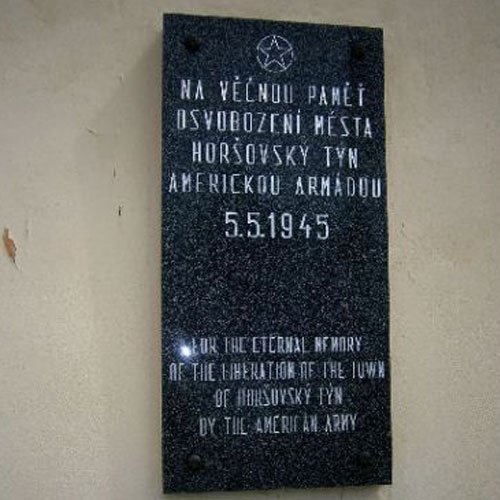
After the occupation of the Czechoslovak borderlands in 1938, Horšovský Týn—as a bastion of Henlein’s Sudeten German Party—became part of the Third Reich and served as a regional seat. It fell within the Egerland government district. The events at the war’s end thus played out a bit differently in the different parts of this district. While the Americans had to fight furiously to advance in the neighborhoods directly by the Czech-German border, the actual liberation of the remainder of Horšovský Týn was only accompanied by a few local conflicts.
One interesting source of testimony on the 2nd Infantry Division’s further advance out of Horšovský Týn into Pilsen is the diary of Col. Matt Konop, the Czech American who established a command station in the local castle on May 5, 1945.
“We settled in at the castle in Horšovský Týn on May 5, 1945; the purely German town is now occupied by our army; the toughest battles were fought nearby Horšovský Týn, at the location of St. Anne’s Church.
Mixed German army and Volkssturm units were fiercely defending a hillock. But Hitlerjugend units put up the toughest resistance of all. We attacked the entrenched German units from the direction of Postřekov.”
The city was liberated at the price of many lives of soldiers on both sides of the conflict. The chronicles list these fallen soldiers as examples: German soldier Theodor Meurer, Corporal Flg. Ausb. Rgt. 63, fallen on May 5, 1945 near St. Anne’s / German soldier Siegfrid Noack, killed by an artillery shell on May 5, 1945 in Horšovský Týn / German soldier Ernst Schreppper, Gefr. Stabskp. Schtz. Rgt. 12, fallen on May 5, 1945 in the forest near Borovice / two unknown German soldiers, fallen on May 5, 1945 near Třebnic / German soldier Johan Müller, Landarbeiter-Volkssturm, fallen on May 5, 1945 in Horšovský Týn / American soldier Francis White, 2nd Infantry Division, fallen on May 5, 1945 near Horšovský Týn / American soldier Walter Early, 2nd Infantry Division, fallen May 5, 1945 near Vidice / German soldier Josef Meller, Uffz. from Wrocław (Breslau at the time), died from injuries in a hospital in June 1945.
The city was liberated—as described in a report by the 38th Infantry Regiment of the US Army—by way of an attack that ended at 7:39 p.m., with the very last shot being fired at 9:00 p.m. outside of Horšovský Týn. Enemy forces and fanatical German civilians were mopped up the next day, on May 6, 1945.
Quite quickly—on May 5—a division command station of the US Army was established in a castle that had formerly housed the Wehrmacht’s command.
“I took my lodgings in a gorgeous room and slept in a real bed for the first time in a long time. Interestingly enough, I slept in a bed that may have been used my ancestors’ oppressor from back in feudal times, count Maximilian Trauttmansdorff.
In the morning I woke up and saw a door in the corner of the room I hadn’t noticed the night before. I went up and slammed it open. A German officer was standing against me, aiming a pistol. I thought that was the end of me. I’d made it through the whole war, and now at its end, I’d be shot in a castle here in Bohemia, from where my ancestors came… But the officer handed me the pistol, saluted, and announced he was surrendering to me as an officer of the US Army. I took that pistol as plunder and led the officer off among the other captured German soldiers.
I had my breakfast, and the unit and I continued on towards Holýšov and from there to Pilsen.”
“Na věčnou paměť osvobození města Horšovský Týn Americkou armádou 5. 5. 1945” (“To the eternal memory of the US Army’s liberation, May 5, 1945”)
GPS: 49°31'47.95"N 12°56'40.42"E